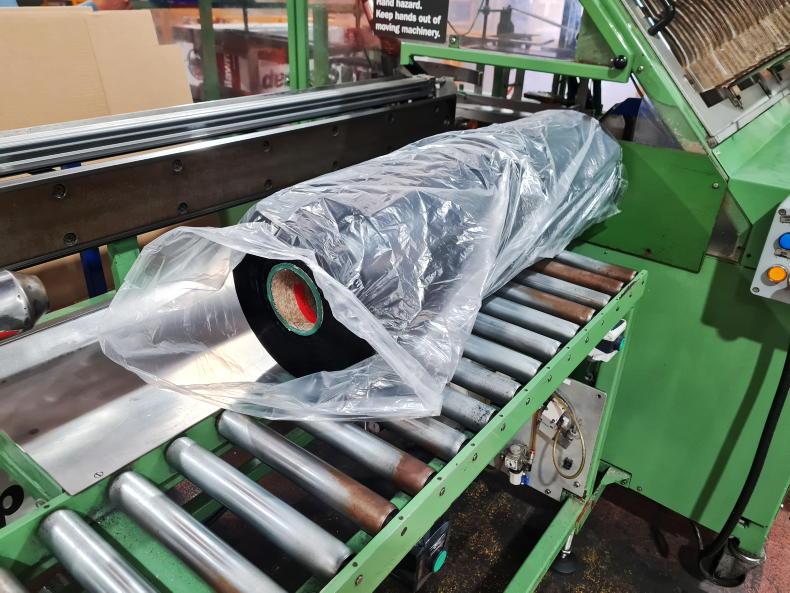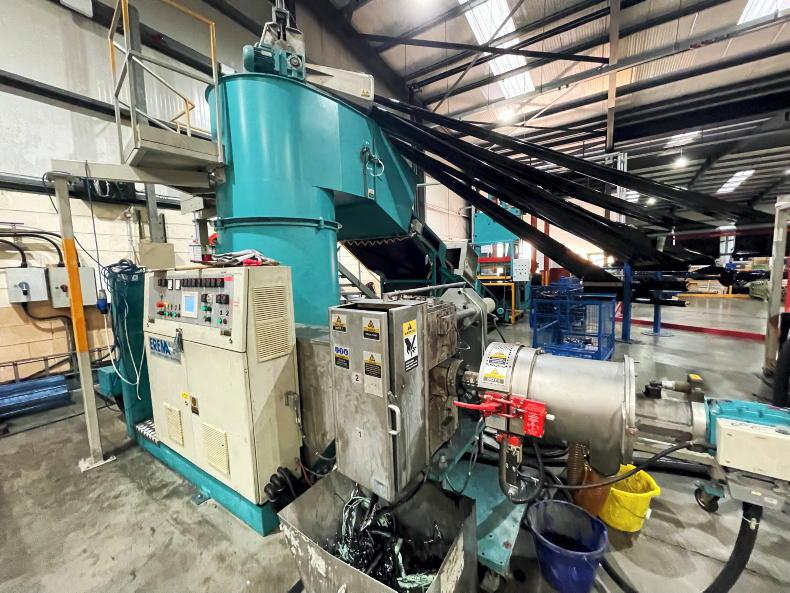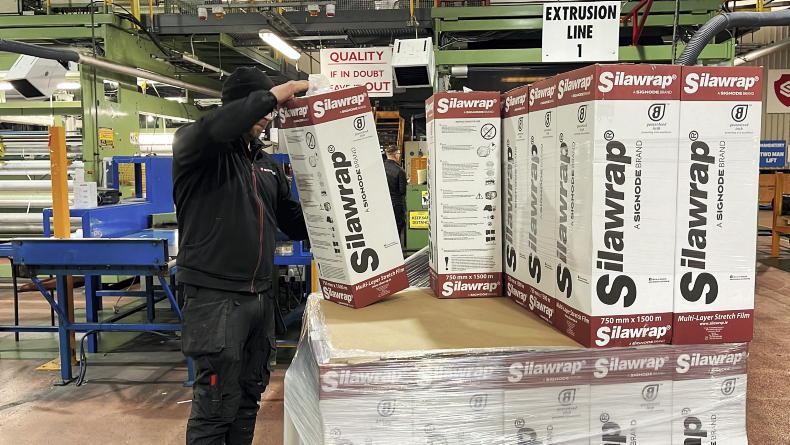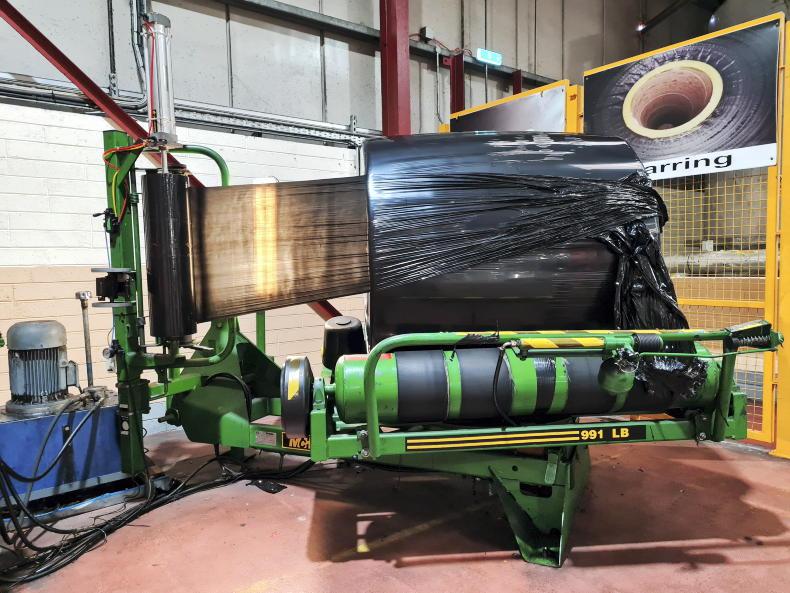Bale silage has become a massive business in Ireland over the past 30 years. The film used to ensile the forage is a key factor in this process. We travelled to the Silawrap factory in Gorey in Co Wexford to take a look at the film manufacturing process.
Background
The Silawrap factory in Gorey was originally built in 1996 by Integrated Packing (IP) Europe having spotted an opening in the Irish market to move away from bagging grass silage to wrapping it. This was a successful move considering Ireland today accounts for 50% of Silawrap’s annual production. Production is split, 90% bale film and 10% NRF Net Replacement film.
The factory has changed ownership multiple times and today is a brand of the Signode Group, owned by Crown Holdings. Signode specialises in transit packaging, with over 80 manufacturing facilities across six continents.
The Wexford facility started out with two production lines before significant expansion in 2000 added on another three production lines. Today, the company employs 52 people and operates each of the five lines 24 hours a day, all year round. Thirty per cent of the firm’s annual film production is delivered to customers in the month of May. 
“It's not a ‘one fits all’ approach, different markets have different climates so therefore we may need to make certain adjustments to resin quantities".
Ingredients
Silawrap is produced from polyethylene (PE) resins derived from oil and gas, hence the sharp rise in wrap price this season. Silawrap uses linear low-density PE (LLDPE) resins in the production process. LLDPE resins are split into C4, C6 and C8 resins with the numbers 4, 6 and 8 detailing the number of bonds between the molecules. Silawrap area manager Maurice Keady confirms the company uses 100% C8 resins which are selected based on elasticity and strength properties.
“In total there are five resins used in our multi-layer film. These include a glue/tack to help seal the film, master batch which is the black or green colouring agent, UV light inhibitors to prevent film breakdown in sunshine, as well as resins for elasticity and puncture resistance.” 
The resins are mixed and heated to 240-degrees to become molten and fed through screw augers into a central extruder.
Maurice noted how the ingredients vary depending on the market the order is destined for. “It’s not a ‘one-fits-all’ approach. Different markets have different climates so therefore we may need to make certain adjustments to resin quantities. For example, countries like Australia where there are higher levels of UV light require a higher percentage of UV light inhibitor and green or white coloured master batch instead of black.”
These prilled urea-like granular resins arrive to Silawrap in bulk form and are blown into large silos. There are six large silos on-site which account for just one week’s production. 
Silawrap use five resins in its three-layer film; a glue/tack to help seal the film, master batch which is the black or green colouring agent, UV light inhibitors to prevent film breakdown in UV light, as well as resins for elasticity and puncture resistance.
“We’re not able to store enough raw materials to last us for six months. This was never an issue over the last 22 years until last autumn and January this year. For the first time ever, we ran short of resins due to supply chain issues. As we operate the factory 24/7, we can’t make up for lost time. The several weeks production we lost over the past seven months means our annual production for the year ahead is down 7%,” said Maurice. 
The film is applied onto the carboard cores six at a time, three on either side.
Extrusion process
Each of the different resins are automatically weighed, and fed into a central hopper at ambient temperature. They are then mixed and heated up to 240° to become molten.
Three screw augers, somewhat like a butcher’s press, feed the molten plastic into a central extruder. The plastic is fed through a circular mandrel, and pulled upwards four stories (30m) high in a cone shape.
Cold air is circulated in the centre of this cone, to reduce the temperature to 70°C at entry, and down to 25°C before it goes through the nip roller at the top, where the layers are closed, and pressed together. The speed at which the film is extruded determines the thickness of the film, which is a consistent 25 microns thick.
This film is fed around to the packaging area. It is applied onto the carboard cores six at a time. Once complete, each roll is manually bagged, labelled, boxed and loaded onto a pallet.
The final stage of the process is known as hot boxing. The entire pallet of film is heated up to 70-degrees for eight hours to bring out the tack, which ensures the film sticks when being applied to a bale. All film is retained on-site for seven days afterwards to cure. 
Each roll is manually bagged, labelled, boxed and loaded onto a pallet.
Quality control
During the manufacturing process samples are taken on a random basis for testing. Each sample is tested for puncture resistance, UV light and weather resistance as well as tear and cling measurements. In addition, a random roll is placed on the static McHale test wrapper where a bright light shines through the film as it’s being applied. The operator here looks for visual imperfections. Samples are taken for testing four times during every 24-hour period. 
Any rolls with imperfections are chopped up and melted before being processed into prills, where it is sent to manufacturer black security pallet wrap.
Each of the five production lines have full traceability, with one piece of film from every six rolls produced retained for four years. Every roll and pallet produced has full traceability, down to the raw materials used, when it was made, and the line it came off.
One in 12 rolls produced is weighed to ensure there are no inconsistencies. Any rolls with imperfections are chopped up and melted before being processed into prills, where they sent to manufacturer black security pallet wrap. 
Each roll is manually bagged, labelled, boxed and loaded onto a pallet.
Markets
“Ireland is our largest market. It accounts for 50% of all our production. This is followed by Britan which consumes a further 20% of production. The vast majority of the wrap supplied into these markets is black plastic,” said Maurice. “France accounts for a further 10%, with the remaining share divided between Australia, New Zealand, Holland, Norway, Sweden and Germany. The majority of our film supplied to these markets is of a light green/white colouring. Bales in these markets could be sitting in 30°C weather for months, so this film is designed to reflect heat. 
Random rolls are tested on the static McHale wrapper where a bright light shines through the film as it's being applied to check for visual imperfections.
Costings
“Our production cycle is from September to August. Taking September to the end of April 2020/21 v 2021/22, our resin material costs have gone up €32 per roll including VAT. 90% of our total cost increases is down to resin price increases, with the remainder being packaging, transport and energy costs. Resins are expected to go up a further €10 per roll in May and June,” explained Maurice.
Bale silage has become a massive business in Ireland over the past 30 years. The film used to ensile the forage is a key factor in this process. We travelled to the Silawrap factory in Gorey in Co Wexford to take a look at the film manufacturing process.
Background
The Silawrap factory in Gorey was originally built in 1996 by Integrated Packing (IP) Europe having spotted an opening in the Irish market to move away from bagging grass silage to wrapping it. This was a successful move considering Ireland today accounts for 50% of Silawrap’s annual production. Production is split, 90% bale film and 10% NRF Net Replacement film.
The factory has changed ownership multiple times and today is a brand of the Signode Group, owned by Crown Holdings. Signode specialises in transit packaging, with over 80 manufacturing facilities across six continents.
The Wexford facility started out with two production lines before significant expansion in 2000 added on another three production lines. Today, the company employs 52 people and operates each of the five lines 24 hours a day, all year round. Thirty per cent of the firm’s annual film production is delivered to customers in the month of May. 
“It's not a ‘one fits all’ approach, different markets have different climates so therefore we may need to make certain adjustments to resin quantities".
Ingredients
Silawrap is produced from polyethylene (PE) resins derived from oil and gas, hence the sharp rise in wrap price this season. Silawrap uses linear low-density PE (LLDPE) resins in the production process. LLDPE resins are split into C4, C6 and C8 resins with the numbers 4, 6 and 8 detailing the number of bonds between the molecules. Silawrap area manager Maurice Keady confirms the company uses 100% C8 resins which are selected based on elasticity and strength properties.
“In total there are five resins used in our multi-layer film. These include a glue/tack to help seal the film, master batch which is the black or green colouring agent, UV light inhibitors to prevent film breakdown in sunshine, as well as resins for elasticity and puncture resistance.” 
The resins are mixed and heated to 240-degrees to become molten and fed through screw augers into a central extruder.
Maurice noted how the ingredients vary depending on the market the order is destined for. “It’s not a ‘one-fits-all’ approach. Different markets have different climates so therefore we may need to make certain adjustments to resin quantities. For example, countries like Australia where there are higher levels of UV light require a higher percentage of UV light inhibitor and green or white coloured master batch instead of black.”
These prilled urea-like granular resins arrive to Silawrap in bulk form and are blown into large silos. There are six large silos on-site which account for just one week’s production. 
Silawrap use five resins in its three-layer film; a glue/tack to help seal the film, master batch which is the black or green colouring agent, UV light inhibitors to prevent film breakdown in UV light, as well as resins for elasticity and puncture resistance.
“We’re not able to store enough raw materials to last us for six months. This was never an issue over the last 22 years until last autumn and January this year. For the first time ever, we ran short of resins due to supply chain issues. As we operate the factory 24/7, we can’t make up for lost time. The several weeks production we lost over the past seven months means our annual production for the year ahead is down 7%,” said Maurice. 
The film is applied onto the carboard cores six at a time, three on either side.
Extrusion process
Each of the different resins are automatically weighed, and fed into a central hopper at ambient temperature. They are then mixed and heated up to 240° to become molten.
Three screw augers, somewhat like a butcher’s press, feed the molten plastic into a central extruder. The plastic is fed through a circular mandrel, and pulled upwards four stories (30m) high in a cone shape.
Cold air is circulated in the centre of this cone, to reduce the temperature to 70°C at entry, and down to 25°C before it goes through the nip roller at the top, where the layers are closed, and pressed together. The speed at which the film is extruded determines the thickness of the film, which is a consistent 25 microns thick.
This film is fed around to the packaging area. It is applied onto the carboard cores six at a time. Once complete, each roll is manually bagged, labelled, boxed and loaded onto a pallet.
The final stage of the process is known as hot boxing. The entire pallet of film is heated up to 70-degrees for eight hours to bring out the tack, which ensures the film sticks when being applied to a bale. All film is retained on-site for seven days afterwards to cure. 
Each roll is manually bagged, labelled, boxed and loaded onto a pallet.
Quality control
During the manufacturing process samples are taken on a random basis for testing. Each sample is tested for puncture resistance, UV light and weather resistance as well as tear and cling measurements. In addition, a random roll is placed on the static McHale test wrapper where a bright light shines through the film as it’s being applied. The operator here looks for visual imperfections. Samples are taken for testing four times during every 24-hour period. 
Any rolls with imperfections are chopped up and melted before being processed into prills, where it is sent to manufacturer black security pallet wrap.
Each of the five production lines have full traceability, with one piece of film from every six rolls produced retained for four years. Every roll and pallet produced has full traceability, down to the raw materials used, when it was made, and the line it came off.
One in 12 rolls produced is weighed to ensure there are no inconsistencies. Any rolls with imperfections are chopped up and melted before being processed into prills, where they sent to manufacturer black security pallet wrap. 
Each roll is manually bagged, labelled, boxed and loaded onto a pallet.
Markets
“Ireland is our largest market. It accounts for 50% of all our production. This is followed by Britan which consumes a further 20% of production. The vast majority of the wrap supplied into these markets is black plastic,” said Maurice. “France accounts for a further 10%, with the remaining share divided between Australia, New Zealand, Holland, Norway, Sweden and Germany. The majority of our film supplied to these markets is of a light green/white colouring. Bales in these markets could be sitting in 30°C weather for months, so this film is designed to reflect heat. 
Random rolls are tested on the static McHale wrapper where a bright light shines through the film as it's being applied to check for visual imperfections.
Costings
“Our production cycle is from September to August. Taking September to the end of April 2020/21 v 2021/22, our resin material costs have gone up €32 per roll including VAT. 90% of our total cost increases is down to resin price increases, with the remainder being packaging, transport and energy costs. Resins are expected to go up a further €10 per roll in May and June,” explained Maurice.














 This is a subscriber-only article
This is a subscriber-only article










SHARING OPTIONS: